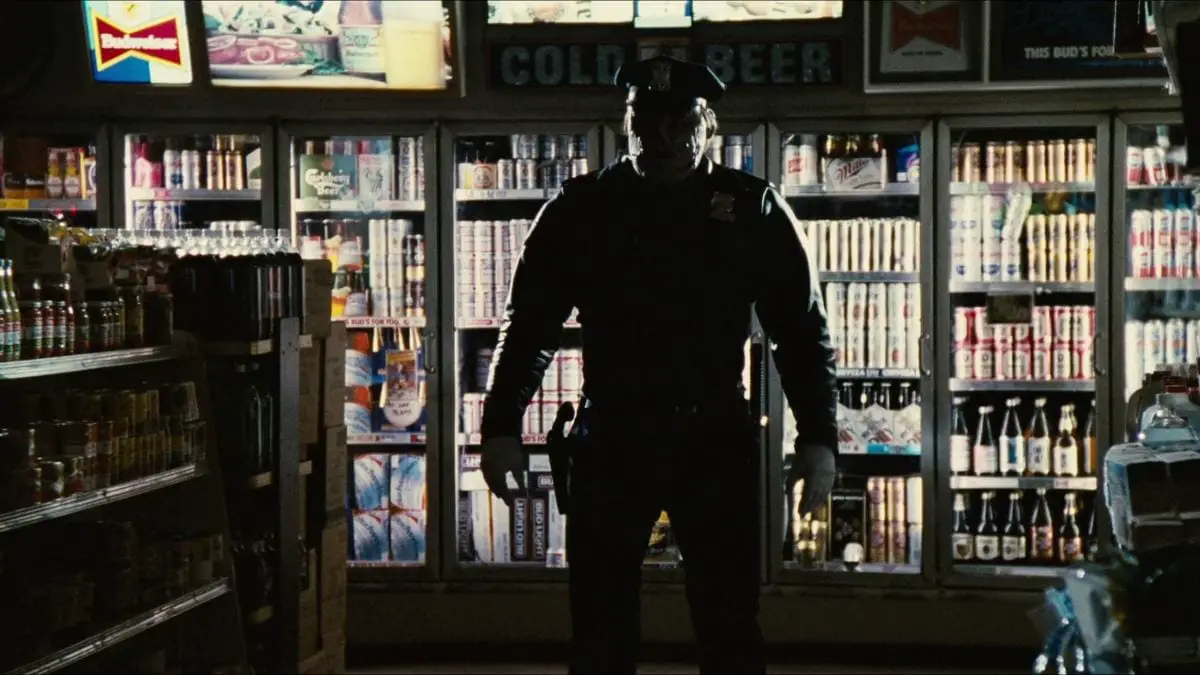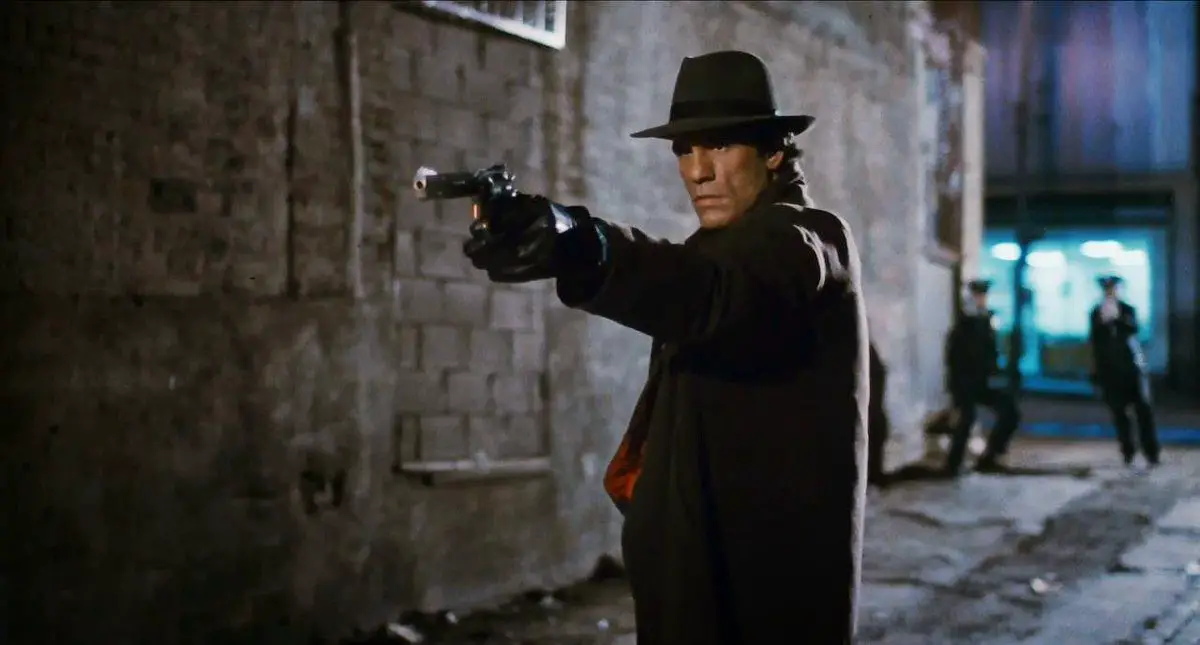Welcome to this column dedicated to my appreciation of physical media supplements called: Feature Presentations. The goal of this column is not to say whether a film is good or bad and worth picking up or not—I would like to highlight the discs that go the extra mile and provide film fans with enough tasty tidbits to satisfy even the hungriest of cinephiles. With all that out of the way, today’s article will focus on Maniac Cop 3: Badge of Silence from Blue Underground.

What comes to mind when you think of the greatest horror franchises? The heavy hitters will come up first: Jason, Freddy, Michael—hell, even Chucky might make it with his resurgence on TV. There’s plenty to choose from, but one franchise often gets shunned more than it should. Since you’re reading this article, you know it’s time to talk about the Maniac Cop series, specifically, the red-headed stepchild, Maniac Cop 3.
I don’t recall when I first became familiar with the Maniac Cop series, but I know it was when I was young and impressionable. Watching the titular Matt Cordell wreak havoc on those who wronged him throughout New York City sounded like a good time. And thanks to the talent involved, the exploitation plot of the film transcends the typical fare of this genre. All thanks need to be directed at the creative team in front and behind the camera.
While most of the talent followed in step to the superior sequel, the creative train halted with the third entry. The production history for Badge of Silence deserves an article of its own—needless to say: the production was a nightmare. From Larry Cohen not rewriting the script after the distributors objected to having a Black lead to director William Lustig walking out halfway through the shoot, nothing went right for the third entry.
As someone who eats up film production history, I find behind-the-scenes turmoil fascinating. I’m never one to cheer for things to go south on a film set, but understanding the inner workings of production difficulties captivates me like no other. Whether it’s in-depth documentaries, insightful interviews, or honest audio commentaries, I want to know every morsel from pre-production through the physical media release.
When Maniac Cop 3 debuted on Blu-ray from Blue Underground, the disc came with the making-of documentary, “Wrong Arm of the Law,” and a collection of deleted and extended scenes. Thankfully, the upgrade to 4K ports over these existing extras. As someone who never picked up the Blu-ray copy of Maniac Cop 3, this was my first viewing of “Wrong Arm of the Law.”
Clocking in at 25 minutes, this featurette breaks down the turmoil of the film’s production. Everyone speaks openly and honestly about the trials and tribulations, from script problems to William Lustig walking off during filming and Maniac Cop 3 making money on the home video market. Beyond the details surrounding the on-set struggles, the best part about having this feature on the disc is that some on the featurette are no longer with us.
Even if talking about a film he is not proud of, it is always welcome to hear from screenwriter Larry Cohen. While he only speaks for a few moments, Larry is Larry and details his side of the threequel’s turbulent production—his unique voice is sorely missed.
Equally missed, yet chronicled on “Wrong Arm of the Law,” is Matt Cordell himself, Robert Z’Dar. As with Larry Cohen, Z’Dar, only appears briefly, though more positive about the making of Maniac Cop 3. Nothing Z’Dar has to say is earth-shattering, but it’s welcoming to hear the man talk about his (arguably) most famous role.

Next up are a handful of deleted and extended scenes totaling under ten minutes. None of the included scenes offer a reason to stay in the finished product. Hearing the behind-the-scenes drama of the film struggling to hit its runtime, I’m surprised some of these didn’t end up in the final cut. As someone who loves the franchise top-to-bottom, having these scenes is a welcome addition.
Blue Underground included marketing materials in the form of a theatrical trailer along with a poster and still gallery. As a trailer is to excite the masses about the feature film, it does a well enough job at it. The poster and stills gallery houses multiple posters and VHS covers with only a few film stills offered.
The next feature found on the disc is the film’s original synopsis. Here, we have a multi-page breakdown of Larry Cohen’s original idea for Maniac Cop 3. While not the entire script that Cohen crafted, this synopsis allows us insight into what could have been. I haven’t seen something like this offered on any other physical media release; this is an excellent bonus feature, especially if you’re a fan of Larry Cohen or the Maniac Cop series.
The last and most substantial extra comes from a newly-recorded audio commentary from director “Alan Smithee.” Anyone familiar with film knows that the Smithee moniker is when a director wants their name removed from the film. Ruining the surprise, I’ll spoil who is on the commentary track: director William Lustig and producer Joel Soisson.
As someone who has listened to many commentary tracks over the years, you get accustomed to certain types: scholarly and analytical, joke-y, plain Jane. Every commentary track is different, and over the past handful of years, it feels like a certain honesty is harder to come by. I mean that commentary tracks feel paint-by-numbers, whether it’s Paul Talbot detailing Charles Bronson‘s history on the Death Wish films or a straightforward, “A-to-B-to-C” track you might find on a mainstream film like The Invisible Man. There’s nothing wrong with that—this is what commentary tracks are for, but lately, most feel like they come off an assembly line.
I’m not looking for a track that throws everyone under the bus and dishes dirt about anyone and everyone. It’s a weird dichotomy, but sometimes I want to hear production war stories. It’s part of the filmmaking process, but it’s a fine line, so I get why commentaries are safe and focus mainly on the production details, leaving the dirt behind.
All of this is a long way of saying that the commentary track on Maniac Cop 3 is the antithesis of safe. Lustig, who still doesn’t like the film, and Soisson, who hates it less than Lustig, sit down to talk honestly about a difficult time for both men. The honesty starts from the opening moments and never lets up. Each air their grievances about the challenges of making a third entry that was flawed before cameras rolled. As the track rolls on, the vigor subsides, and we get to hear two guys, frustrated with each other at one point in time, coming together to create one of the finest commentaries I’ve heard in a long time.
Again, I don’t want to hear two hours of mudslinging. That’s not the best use of a commentary. What Lustig and Soisson do is perfection: detail what went on, why things happened the way they did, and how that affected the final product. You might say there’s venom here and there, but it’s more like pointed criticism. Both men know what they’re talking about and share their views. They take the listener step-by-step into how a film production got out of hand. The balance the pair pull off makes this a funny yet educational listen.

And there you have it! Is Maniac Cop 3 worth adding to your collection? It’s easily the weakest entry into the trilogy, but if you’re considering getting Badge of Silence, the odds are good you enjoy the first two films as well. Carrying over all pre-existing extras plus the addition of the “Alan Smithee” commentary, this 4K/Blu-ray combo is the ultimate edition for a film that probably doesn’t deserve it, but I’m glad it exists!



